Picture this: you step outside your door and breathe in the crisp morning air while gazing across a vibrant green landscape that seems to pulse with life. Birds chirp from native shrubs, butterflies dance among colorful blooms, and your garden practically hums with the quiet satisfaction of working in harmony with nature. This isn’t just a dream—it’s the reality I’ve created in my own backyard through years of trial, error, and discovery.
When I first started my gardening journey, I thought a beautiful green landscape meant endless watering, chemical fertilizers, and fighting against nature’s natural rhythms. I was wrong. After spending countless weekends wrestling with brown patches, dealing with pest problems, and watching my water bill skyrocket, I realized there had to be a better way. That’s when I discovered the transformative power of sustainable landscaping practices that work with nature rather than against it.
The truth is, creating a lush, thriving garden doesn’t require you to compromise your environmental values or drain your bank account. Through careful observation, research, and plenty of hands-on experimentation, I’ve identified nine game-changing sustainable practices that have completely revolutionized my approach to gardening. These aren’t just theoretical concepts—they’re practical, proven methods that have transformed my outdoor space into a self-sustaining ecosystem that requires less maintenance, uses fewer resources, and provides more beauty than I ever thought possible.
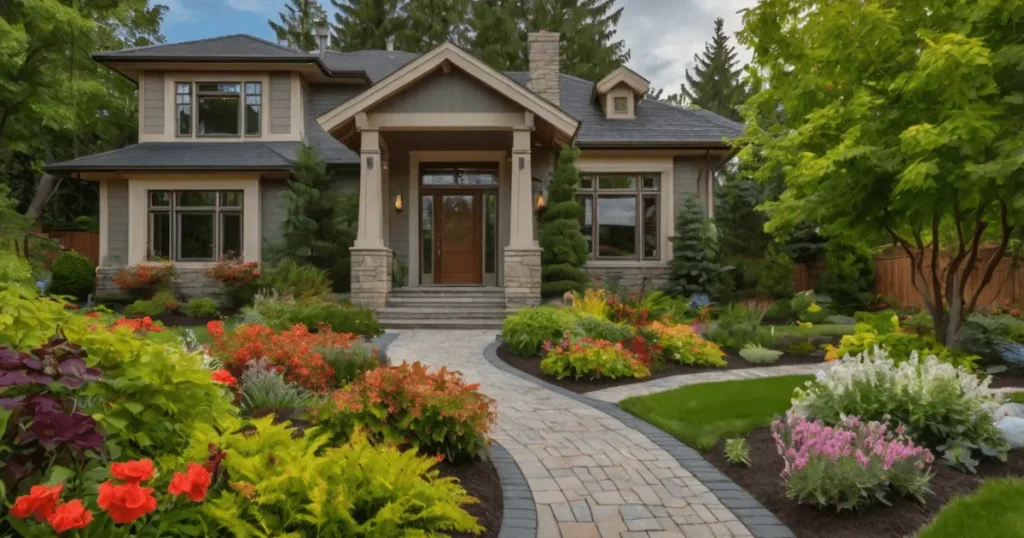
Embrace Native Plants for Landscaping Success
One of my biggest “aha” moments came when I stopped fighting my local climate and started working with it. Native plants for landscaping aren’t just a trendy concept—they’re nature’s way of showing us exactly what thrives in our specific environment without constant intervention.
During my first year of gardening, I spent hundreds of dollars on exotic plants that looked gorgeous in the nursery but struggled in my yard. I was constantly watering, fertilizing, and worrying about whether they’d survive the next season. Then a local master gardener introduced me to the concept of native plant landscaping, and everything changed.
Native plants have evolved over thousands of years to thrive in your specific region’s soil, rainfall patterns, and temperature fluctuations. They’ve developed natural resistance to local pests and diseases, reducing the need for chemical interventions. In my experience, once established, native plants require 50-75% less water than non-native alternatives.
The Lady Bird Johnson Wildflower Center provides an excellent database for finding native plants specific to your region. I’ve found their resources invaluable for planning my sustainable garden design.
Research from the National Wildlife Federation shows that native plants support 29 times more biodiversity than non-native plants. This means your garden becomes a thriving ecosystem that naturally attracts beneficial insects, birds, and other wildlife that help maintain ecological balance.
Implement Water-Efficient Landscaping Techniques
Water scarcity is becoming an increasingly pressing concern, and traditional irrigation methods are both wasteful and expensive. When I calculated how much water my sprinkler system was using during summer months, I was shocked. That’s when I committed to implementing water-wise landscaping techniques that have cut my outdoor water usage by nearly 60%.
Drip Irrigation Systems
I replaced my old sprinkler system with a drip irrigation setup, and the results were immediate. Drip systems deliver water directly to plant roots, reducing evaporation and ensuring every drop counts. According to the EPA, drip irrigation can be 30-50% more efficient than conventional sprinkler systems.
Strategic Plant Grouping
I learned to group plants with similar water needs together—what landscape designers call hydrozoning. My drought-tolerant plants occupy the sunny, well-drained areas, while moisture-loving species thrive in naturally wetter spots. This simple reorganization eliminated the waste of overwatering drought-resistant plants or underwatering those that need more moisture.
Rainwater Harvesting
Installing rain barrels was one of my most satisfying sustainable irrigation improvements. I collect approximately 600 gallons of water from a single inch of rainfall on my 1,000-square-foot roof. This free, chlorine-free water is perfect for my plants and has significantly reduced my reliance on municipal water supplies.
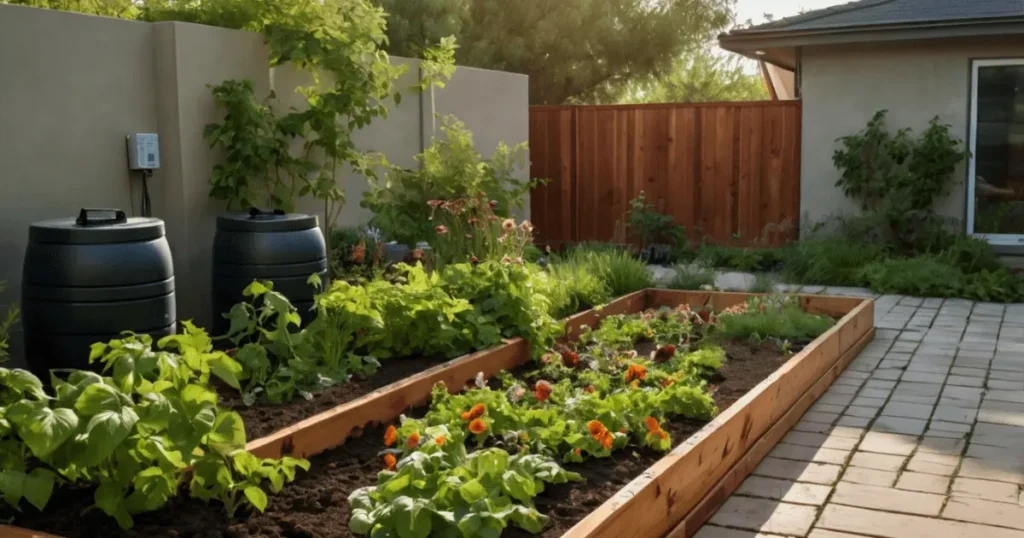
Master Organic Lawn Care Practices
Traditional lawn care relies heavily on synthetic fertilizers and pesticides that can harm beneficial soil organisms and contaminate groundwater. After researching the environmental impact of conventional lawn treatments, I transitioned to organic lawn care methods that have actually improved my grass’s health and resilience.
Soil Testing and Amendment
I started by getting my soil tested through my local extension office—a service that costs less than $20 but provides invaluable information about pH levels, nutrient content, and organic matter. The results showed my soil was compacted and lacking in organic matter, which explained why my grass struggled despite regular fertilizing.
Organic Fertilizers
Instead of synthetic fertilizers, I now use compost, aged manure, and organic fertilizer blends. These feed the soil ecosystem gradually and sustainably. A study published in the Journal of Environmental Quality found that organic fertilizers improve soil structure and water retention compared to synthetic alternatives.
Natural Lawn Maintenance
I’ve adopted the “one-third rule”—never cutting more than one-third of the grass blade length at once. This reduces stress on the grass and promotes deeper root growth. I also leave grass clippings on the lawn as natural mulch, which returns nutrients to the soil and reduces waste.
Create Drought-Tolerant Gardens That Thrive
Xeriscaping ideas have revolutionized how I think about garden design in water-scarce regions. This approach doesn’t mean creating a desert landscape—it means choosing drought-tolerant plants that are both beautiful and resource-efficient.
Succulent Integration
I’ve incorporated various succulents and cacti into my landscape design, creating stunning focal points that require minimal water. These plants store water in their tissues, making them incredibly resilient during dry periods. My jade plants and agave specimens have become conversation starters that demonstrate how water-wise landscaping can be both practical and visually striking.
Mediterranean Plant Palette
Drawing inspiration from Mediterranean climates, I’ve planted lavender, rosemary, olive trees, and ornamental grasses. These plants are naturally adapted to hot, dry summers and mild, wet winters. The bonus is that many of them are also culinary herbs, adding function to form in my landscape design.
Mulching for Moisture Retention
Strategic mulching techniques have been crucial for my drought-tolerant garden’s success. I use a 3-4 inch layer of organic mulch around plants, which reduces evaporation by up to 70% and helps maintain consistent soil moisture levels.
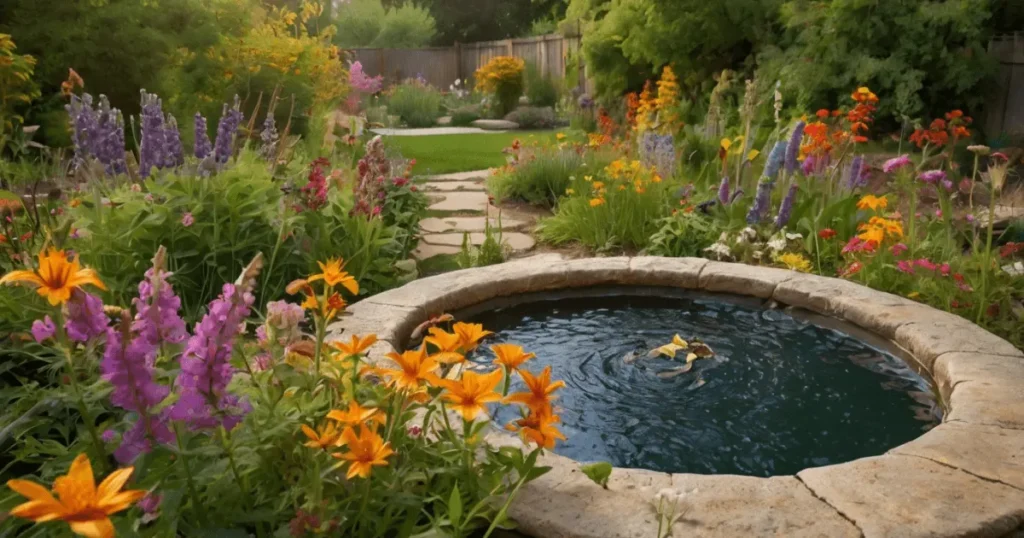
Develop Wildlife Habitat Gardens
One of the most rewarding aspects of sustainable landscaping has been watching my garden transform into a thriving wildlife habitat. Creating spaces that support local fauna isn’t just environmentally responsible—it’s fascinating to observe the intricate relationships that develop in your backyard ecosystem.
Pollinator-Friendly Plants
I’ve dedicated significant space to butterfly gardens and bee-friendly plantings. Research from the Xerces Society shows that native flowering plants provide essential nectar and pollen sources for declining pollinator populations. My bee balm, black-eyed Susan, and native milkweed have attracted dozens of butterfly and bee species.
Bird-Friendly Landscape Features
Creating a bird-friendly landscape involves providing food, water, shelter, and nesting sites. I’ve installed native berry-producing shrubs like elderberry and serviceberry, which provide natural food sources throughout the seasons. A simple birdbath and brush pile for cover have turned my yard into a regular stopover for migrating species.
Layered Vegetation Structure
Professional landscape designers taught me about creating vertical layers in the garden—groundcover, understory plants, and canopy trees. This mimics natural forest ecosystems and provides habitat for different wildlife species at various levels.
Focus on Soil Health Improvement
Healthy soil is the foundation of any successful green landscape, yet it’s often the most overlooked aspect of garden care. After years of treating symptoms rather than addressing root causes, I learned that soil health management is the key to long-term gardening success.
Composting for Gardens
Starting my composting system was intimidating at first, but it’s become one of my most valuable sustainable gardening practices. I compost kitchen scraps, yard waste, and even shredded paper to create “black gold” for my plants. According to the EPA, composting can divert up to 30% of household waste from landfills while creating valuable soil amendment.
Cover Cropping
In areas where I’m not actively growing, I plant cover crops like clover and winter rye. These plants prevent soil erosion, suppress weeds, and add nitrogen and organic matter to the soil when incorporated. This practice, common in sustainable agriculture, has dramatically improved my soil structure over time.
Minimal Tillage Approach
I’ve learned that excessive tilling destroys beneficial soil organisms and disrupts natural soil structure. Instead, I use a no-till approach, adding organic matter to the surface and allowing earthworms and other soil organisms to incorporate it naturally.
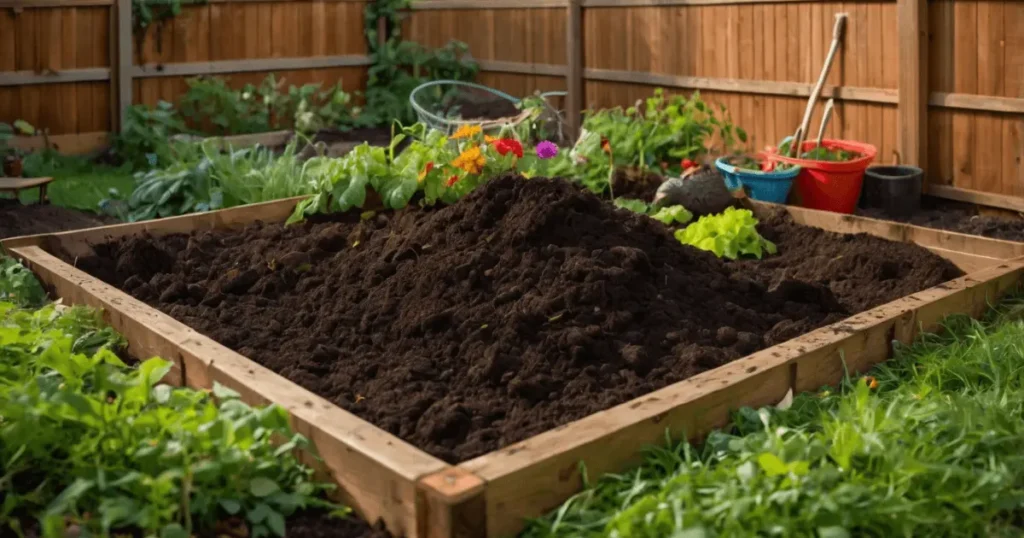
Design Energy-Saving Landscape Features
Strategic landscape design can significantly impact your home’s energy consumption. Through careful planning and plant placement, I’ve created natural climate control that reduces both heating and cooling costs.
Shade Trees for Summer Cooling
I planted deciduous trees on the south and west sides of my home to provide summer shade while allowing winter sunlight through bare branches. The Department of Energy estimates that properly placed shade trees can reduce air conditioning costs by 15-35%.
Windbreaks for Winter Protection
On the north side of my property, I established a windbreak using evergreen trees and shrubs. This natural barrier reduces wind speed and helps insulate my home during winter months. Studies show that effective windbreaks can reduce heating costs by 10-40%.
Energy-Efficient Garden Lighting
For evening ambiance, I’ve installed solar-powered LED lights throughout my garden paths. These systems charge during the day and provide gentle illumination without increasing my electricity bill. Modern solar garden lights are surprisingly effective and add both safety and beauty to outdoor spaces.
Practice Low-Impact Landscaping Methods
Sustainable landscape design involves minimizing environmental disruption while maximizing ecological benefits. I’ve learned to work with my site’s natural characteristics rather than imposing artificial solutions.
Permaculture Design Principles
Incorporating permaculture design concepts has helped me create a self-sustaining garden ecosystem. I observe natural patterns, stack functions (plants that serve multiple purposes), and create beneficial relationships between different garden elements. For example, my nitrogen-fixing legumes improve soil for neighboring plants while providing food and habitat.
Natural Garden Mulch Alternatives
Instead of purchasing commercial mulch, I use natural materials available on my property. Fallen leaves, grass clippings, and pruned branches become valuable resources rather than waste. This reduces transportation costs and keeps organic matter within my local ecosystem.
Integrated Pest Management
Rather than reaching for pesticides at the first sign of trouble, I practice integrated pest management. This involves encouraging beneficial insects, using physical barriers, and accepting some pest damage as part of natural balance. My garden has achieved equilibrium where pest problems are minimal and rarely require intervention.
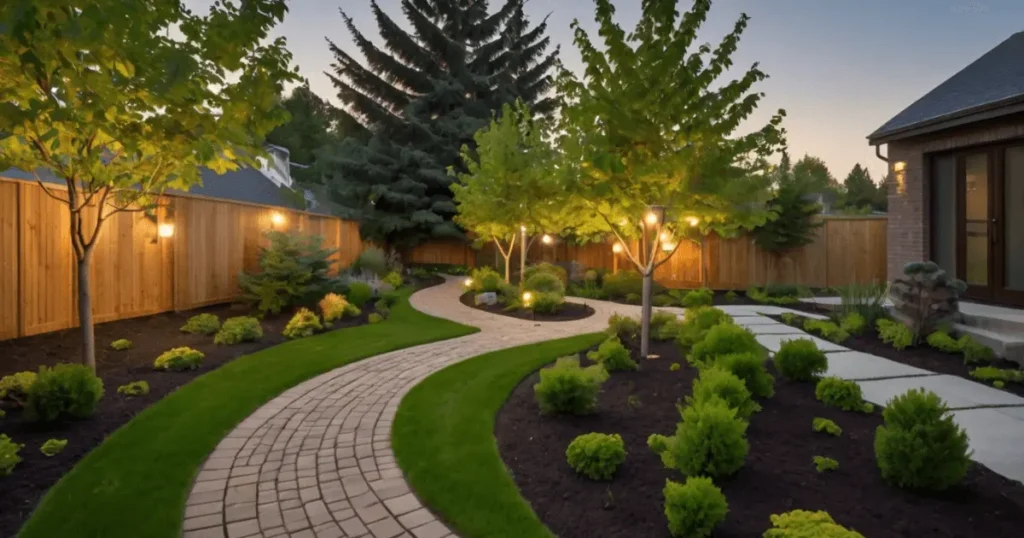
Establish Low-Maintenance Green Spaces
The ultimate goal of sustainable landscaping is creating beautiful spaces that require minimal ongoing intervention. After implementing these practices, I now spend more time enjoying my garden and less time maintaining it.
Perennial Garden Planning
I’ve shifted from annual flowers to perennial plantings that return year after year. While the initial investment is higher, perennials provide long-term value and reduce the need for replanting. My perennial borders now provide four seasons of interest with minimal maintenance.
Lawn Alternatives
In areas where traditional grass struggled, I’ve installed groundcover alternatives like creeping thyme, moss, and native sedges. These options require less water, no mowing, and often provide additional benefits like flowers or wildlife habitat.
Self-Seeding Plant Selection
I’ve chosen plants that readily self-seed, creating natural population expansion and succession. Bachelor’s buttons, cosmos, and native wildflowers have established self-sustaining colonies that provide continuous color with minimal input from me.
Conclusion: What This Journey Has Taught Me About Green Landscapes
Implementing these nine sustainable practices has transformed not just my landscape, but my entire relationship with gardening. What started as a desire to reduce my environmental impact has evolved into a deeper understanding of natural systems and my role within them.
The journey toward sustainable landscaping isn’t about perfection—it’s about progress. I didn’t implement all these practices overnight, and you don’t need to either. Start with one or two techniques that resonate with you, observe the results, and gradually expand your sustainable practices as you gain confidence and experience.
Remember that every property is unique, with its own microclimate, soil conditions, and challenges. What works in my garden may need adaptation for your specific situation. The key is understanding the principles behind these practices and applying them thoughtfully to your own space.
The most rewarding aspect of this journey has been discovering that sustainable landscaping isn’t about sacrifice—it’s about abundance. My garden now provides more beauty, supports more wildlife, requires less maintenance, and costs less to operate than ever before. It’s proof that when we align our gardening practices with natural systems, everyone wins.
Also read – Flowing Elegance: Your Ultimate Guide to Choosing the Right Water Fountain for Home
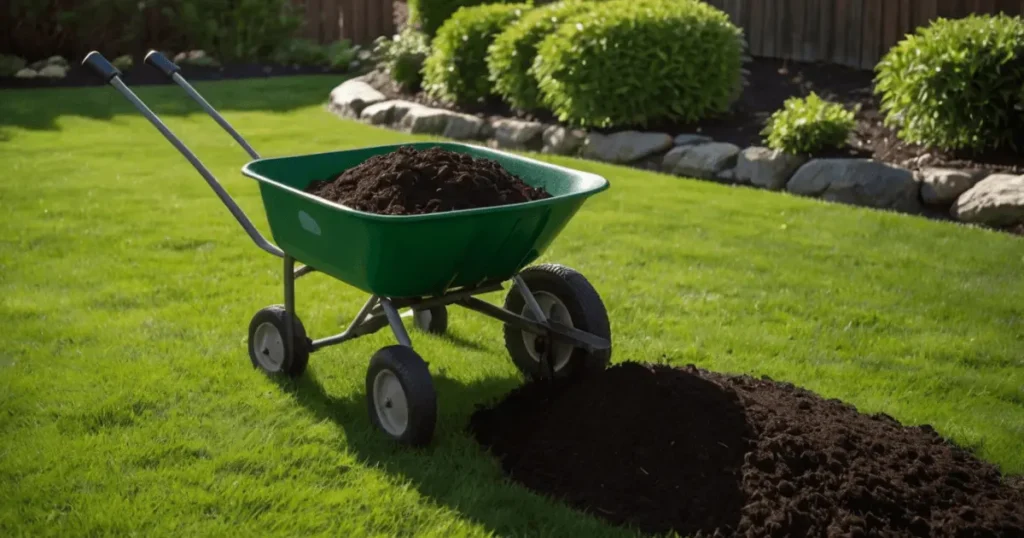
Frequently Asked Questions (FAQs)
What is Eco-Landscaping?
Residential eco-landscaping involves employing native plants with low water and fertilizer requirements and adding stormwater-absorbing features to create stunning, contemporary, and low-maintenance gardens.
What time of year is best to landscape?
April and May are the ideal months to start landscaping and planting trees, shrubs, and perennials. Your plants will have more time to grow and adjust over the summer and fall thanks to these springtime months. Fall, however, is the next best season to start landscaping.
What is the difference between landscape and landscaping?
Gardening done right—with more expertise in the design and building of ponds, sculptures, and topiaries—is called landscaping. The skill of arranging and enhancing an outside area using vegetation and architectural elements for both functional and decorative reasons is known as landscape design.
What is hardscape vs landscape?
Many people are unaware of the distinction between these terms because they are sometimes used synonymously, but it is actually rather easy to comprehend. Your grass and gardens make up your property’s landscape. The patios, walks, and driveway on your property make up the hardscape.
What is softscape landscaping?
All of the living components of a landscape, including trees, flowers, grass, shrubs, and other plants, are referred to as softscapes. Other landscaping techniques including mulching, weed management, grading, mowing, and planting can also be referred to as softscape.
I’d love to hear about your own experiences with sustainable landscaping! Which of these practices resonates most with your gardening goals? Share your success stories, challenges, or questions in the comments below—let’s build a community of gardeners committed to creating beautiful, sustainable green landscapes together.
Disclaimer: The information presented in this article is based on personal experience, research from peer-reviewed sources, and guidance from recognized authorities in sustainable landscaping. While every effort has been made to ensure accuracy, individual results may vary based on local conditions, climate, and implementation methods. Always consult with local extension services or landscape professionals for advice specific to your region and situation.
*Images used in this blog post article are for illustrative purposes only. We do not possess any copyrights to these images unless explicitly mentioned.

Nikhil Shukla
About The Author
Nikhil, with a background in Technology, is deeply passionate about Interior Design and Home Décor. At Cherry Hills Home Living, he channels this passion into creating inviting and stylish living spaces. With a unique blend of analytical thinking and creative flair, Nikhil offers innovative ideas, practical tips, and inspiring guidance to help others transform their homes into cozy retreats.